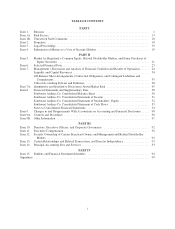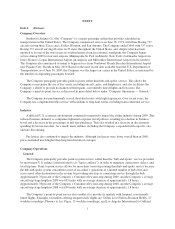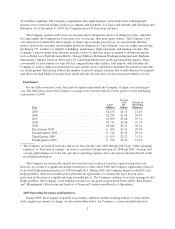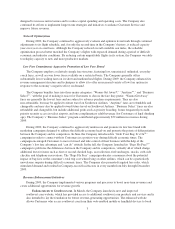Southwest Airlines 2009 Annual Report Download - page 18
Download and view the complete annual report
Please find page 18 of the 2009 Southwest Airlines annual report below. You can navigate through the pages in the report by either clicking on the pages listed below, or by using the keyword search tool below to find specific information within the annual report.The Company’s “Green Team” targets areas of environmental improvement in all aspects of the Company’s
business, while at the same time remaining true to the Company’s low cost philosophy. As part of its
commitment to Environmental Stewardship, the Company has published an Environmental Report describing the
Company’s strategies to reduce greenhouse gas emissions and addressing other environmental matters such as
waste management and recycling. During 2009, the Company unveiled its new “Green Plane,” which will serve
as a test environment for new environmentally responsible materials and Customer comfort products and is
intended to save fuel and related emissions (through weight savings), along with adding recyclable elements to
the cabin interior and reducing waste. As discussed above, the Company has also committed significant resources
towards implementation of RNP procedures, which are designed to conserve fuel and reduce carbon emissions.
Insurance
The Company carries insurance of types customary in the airline industry and at amounts deemed adequate
to protect the Company and its property and to comply both with federal regulations and certain of the
Company’s credit and lease agreements. The policies principally provide coverage for public and passenger
liability, property damage, cargo and baggage liability, loss or damage to aircraft, engines, and spare parts, and
workers’ compensation.
Through the 2003 Emergency Wartime Supplemental Appropriations Act (the “Wartime Act”), the federal
government has provided renewable, supplemental, first-party, war-risk insurance coverage to commercial
carriers at substantially lower premiums than prevailing commercial rates and for levels of coverage not available
in the commercial market. The government-provided supplemental coverage from the Wartime Act is currently
set to expire on August 31, 2010. Although another extension beyond this date is expected, if such coverage is
not extended by the government, the Company could incur substantially higher insurance costs or unavailability
of adequate coverage in future periods.
Competition
Competition within the airline industry is highly competitive and unpredictable, and the Company currently
competes with other airlines on a majority of its routes. Key competitive factors within the domestic airline
industry include pricing, routes and scheduling, and Customer Service.
Pricing in the airline industry can be impacted by a variety of factors. For example, as has been the case in
recent periods, carriers use discount fares to stimulate traffic in an effort to improve load factors and cash flow.
Carriers also discount fares to drive traffic in new markets. More generally, in recent years, the industry has
experienced increased price competition due to (i) the increased presence of carriers with low cost structures
similar to the Company’s and (ii) the impact of carriers who have successfully reorganized within and outside of
bankruptcy and have therefore been able to lower their operating costs. These types of factors reduce the pricing
power of the airline industry as a whole, and the increased availability of fare information on the Internet allows
travelers to easily compare fares and identify competitor promotions and discounts. The Company’s low cost
operating structure is designed to enable it to charge competitive fares.
The Company also competes based on markets served and flight schedules. Many major U.S. airlines have
more extensive route structures and marketing and codesharing alliances that facilitate their expansion to new
destinations; however, the Company’s point-to-point route structure enables it to offer a high percentage of
non-stop flights.
The Company also competes with other airlines in areas of Customer Service such as ontime performance,
passenger amenities, equipment type, and comfort. According to the most current statistics published by the
DOT, the Company consistently ranks at the top for Customer Satisfaction for having the lowest Customer
complaint ratio.
10
























